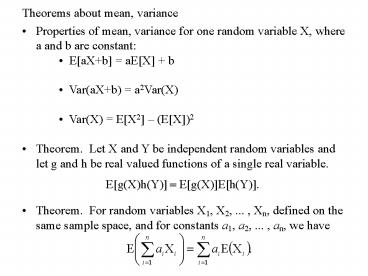Distribution of a function of a random variable - PowerPoint PPT Presentation
1 / 10
Title:
Distribution of a function of a random variable
Description:
Properties of mean, variance for one random ... Properties of covariance. Let X and Y be random variables. Then. If we take Yj = Xj, then (iv) implies that ... – PowerPoint PPT presentation
Number of Views:38
Avg rating:3.0/5.0
Title: Distribution of a function of a random variable
1
Theorems about mean, variance
- Properties of mean, variance for one random
variable X, where a and b are constant
EaXb aEX b Var(aXb)
a2Var(X) Var(X) EX2 (EX)2 - Theorem. Let X and Y be independent random
variables and let g and h be real valued
functions of a single real variable. - Theorem. For random variables X1, X2, ... , Xn,
defined on the same sample space, and for
constants a1, a2, ... , an, we have
2
Mean and median may differ
- Consider an exponential r. v. with ? 1. The
density is - Note that the mean µ and the median m are
different. The density has a lot of weight in
the tail which causes the mean to be larger. We
say that this density is skewed to the right.
m 0.693
µ1
3
Statistical Estimation
- Suppose we are given a random variable X with
some unknown probability distribution. We want
to estimate the basic parameters of this
distribution, like the expectation of X and the
variance of X. - The usual way to do this is to observe n
independent variables all with the same
distribution as X. To estimate the unknown mean
? of X, we use the sample mean described on the
next slide. The value of the observations yield
a value for the sample mean which is used as an
estimate for ?. In a similar way, the sample
variance (discussed later) is used to estimate
the variance of X.
4
The sample mean
- Let X1,X2,,Xn be independent and identically
distributed random variables having c. d. f. F
and expected value µ. Such a sequence of random
variables is said to constitute a sample from the
distribution F. The sample mean is denoted by
and is defined by - By using the theorem on the previous slide, we
have - Thus, the expected value of the sample mean is µ,
the mean of the distribution. For this reason,
is said to be an unbiased estimator of µ. - The random variable is an example of a
statistic. That is, it is a function of the
observations which does not depend on the unknown
parameter µ.
5
Expectation of Bernoulli and binomial random
variables
- Recall that a Bernoulli random variable Xi is
defined by - Since Xi is a discrete random variable, we have
- Let X be a binomial random variable with
parameters (n, p). Then X X1 X2 Xn where
each Xi is Bernoulli. By the theorem from the
previous slide,
which agrees with the direct computation we did
earlier.
6
Covariance, variance of sums, and correlation
- Definition. The covariance between r.v.s X and
Y, denoted by Cov(X,Y), is defined by - Theorem.
- Corollary. If X and Y are independent, then
Cov(X, Y) 0. - Example. Two dependent r. v.'s X and Y might
have Cov(X, Y) 0. Let X be
uniform over (1, 1) and let Y X2.
7
Properties of covariance
- Let X and Y be random variables. Then
- If we take Yj Xj, then (iv) implies that
- If Xi and Xj are independent when i and j differ,
then the latter equation becomes
8
Sample variance
- Let X1,X2,,Xn be independent and identically
distributed random variables having c. d. f. F,
expected value µ, and variance ?2. Let be
the sample mean. The random variable
is called the sample
variance. - Using the results from previous slides, we have
9
Variance of a binomial random variable
- Recall that a Bernoulli random variable Xi is
defined by Also,
Var(Xi) p p2 as an easy computation shows
(taking advantage of the fact that - Let X be a binomial random variable with
parameters (n, p). Then X X1 X2 Xn where
each Xi is Bernoulli. By the result from a
previous slide, - Upon combining the above results, we
have which agrees with our
earlier result.
10
Possible relations between two random variables,
X and Y
- For random variables X and Y, Cov(X,Y) might be
positive, negative, or zero. - If Cov(X, Y) gt 0, then X and Y decrease together
or increase together. In this case, we say X and
Y are positively correlated. - If Cov(X, Y) lt 0, then X increase while Y
decreases or vice versa. In this case, we say X
and Y are negatively correlated. - If Cov(X, Y) 0, we say that X and Y are
uncorrelated. Recall that uncorrelated random
variables may be dependent, however.

